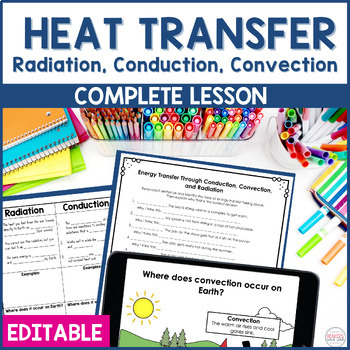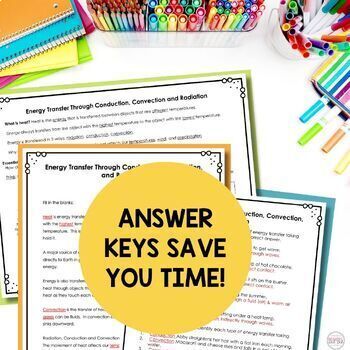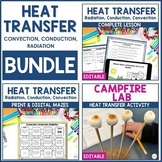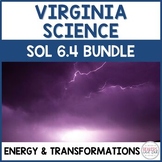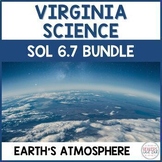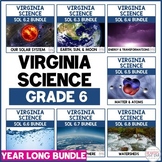Conduction Convection and Radiation Heat Transfer in Earth's Atmosphere
- Zip
What educators are saying
Also included in
- Convection, conduction, and radiation don't have to be difficult to teach! This resource includes no-prep activities that will help your students understand, practice, and investigate methods of thermal energy transfer, including conduction, convection, and radiation.Inside this thermal energy bundPrice $9.20Original Price $11.50Save $2.30
- Are you looking for an engaging, organized, unit to teach Earth's atmosphere and its layers, Earth's energy budget, and the greenhouse effect? Save hours of planning with this ready-to-go unit that includes a pacing guide to help you plan your lessons! Help students understand the relationship betwPrice $33.25Original Price $36.75Save $3.50
- Are you a Virginia teacher looking for no-prep, ready to use resources to teach energy types, Earth's energy budget and transformations? Your students will learn about the importance of the sun, Earth's energy budget, radiation, conduction, and convection as well as energy transformations in thesePrice $17.00Original Price $21.75Save $4.75
- Make your weather and atmosphere unit a breeze with this no-prep, ready-to-use resource. You'll love this engaging unit that includes a pacing guide to help you plan! Learn about thermal energy, weather conditions, weather maps, fronts, weather systems, and measurements with these lessons, labs, anPrice $62.00Original Price $68.25Save $6.25
- "I truly do not know what I would have done without this resource. Worth every penny." Teaching sixth grade science standards in Virginia is a snap! For a little over $1 a day, your lessons are ready to go and aligned to the 2018 SOLS (Standards of Learning). This bundle includes engaging science aPrice $257.40Original Price $286.00Save $28.60
Description
Understanding how convection, conduction, and radiation work together to heat Earth's atmosphere is a snap with this no-prep, editable resource! Inside this heat transfer complete lesson, you will find an editable PowerPoint presentation, editable, differentiated note-taking, practice worksheets, heat transfer anchor chart, and vocabulary word wall cards!
Click the preview button for an up-close look!
What is included in this heat transfer resource:
- Comprehensive presentation
- Differentiated notes (completed, cloze, blank)
- Practice worksheets with an optional word bank and answer key
- 3 Vocabulary cards for your word wall (black and white included for easy printing)
- Editable text presentation and editable notes and worksheets
- Anchor chart
Objectives:
1. Explain conduction, conduction, and radiation and give examples of each.
2. Explain how convection, conduction, and radiation contribute to the heating of our atmosphere.
Why purchase this product?
- Editable!
- Includes ideas for differentiation
- No prep, just print and go, which saves you time!
- Engaging for students
- Tested in my classroom
- Aligned to standards
- Everything you need to teach the standard thoroughly
Teachers like you said....
⭐ ⭐ ⭐ ⭐ ⭐ This was easy to set up and use right away. The guided notes where easy for my students to use and follow along with. -Samantha
⭐ ⭐ ⭐ ⭐ ⭐ This was great. My students were engaged while taking notes. They also enjoyed the example pictures with the notes. -Kim
You May Also Like These Related Products
⭐Heat Transfer Mazes (convection, conduction, radiation)
⭐ Earth's Atmosphere Composition and Layers Complete Lesson
⭐ Earth's Atmosphere Task Cards
⭐ Earth's Atmosphere Complete Bundle - save 20%
⭐ Earth's Energy Budget and Greenhouse Effect
⭐Customer Tip - Submit feedback to earn TPT credit!⭐
Go to your "My Purchases" page. For each purchase, there is a "Provide Feedback" link. Click it to be taken to a page where you can give a quick rating and leave a short comment for the product. Every time you give feedback, TPT gives you credit that you may use to lower the cost of your future purchases!
Let's Get Connected!!
❥Email - carrie@beakersandink.com
❥Join our Facebook page!
❥Follow me on Pinterest and Instagram
❥Check out our BLOG and get access to the Free Resource Library!

